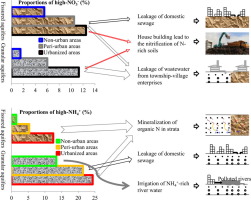当前位置:
X-MOL 学术
›
J. Hydrol.
›
论文详情
Our official English website, www.x-mol.net, welcomes your
feedback! (Note: you will need to create a separate account there.)
Distributions and origins of nitrate, nitrite, and ammonium in various aquifers in an urbanized coastal area, south China
Journal of Hydrology ( IF 5.9 ) Pub Date : 2020-03-01 , DOI: 10.1016/j.jhydrol.2019.124528 Ming Zhang , Guanxing Huang , Chunyan Liu , Ying Zhang , Zongyu Chen , Jincui Wang
Journal of Hydrology ( IF 5.9 ) Pub Date : 2020-03-01 , DOI: 10.1016/j.jhydrol.2019.124528 Ming Zhang , Guanxing Huang , Chunyan Liu , Ying Zhang , Zongyu Chen , Jincui Wang

|
Abstract High nitrogen loading in aquifers is an important issue because of its harmful effects on human health; its origins are often complicated, especially in urbanized areas. This study aims to investigate the distributions of nitrate, nitrite, and ammonium in various aquifers in the Pearl River Delta, and to identify their main sources using hydrochemical and socioeconomic data and principal component analysis. The results show that groundwater with high nitrate (>20 mg/L as N), high nitrite (>1 mg/L as N), and high ammonium (>0.5 mg/L as N) appeared in 7.0%, 4.3%, and 20.5% of granular aquifers, and in 8.3%, 0.8%, and 5.3% of fissured aquifers, respectively, but did not appear in karst aquifers. The proportions of high-nitrate and high-ammonium groundwater in urbanized areas were nearly or more than twice those in non-urbanized areas. High nitrate levels in both granular and fissured aquifers originated mainly from the wastewater leakage of township-village enterprises during the industrialization. Urbanization accompanied by leakage of domestic sewage was another main driving force for high nitrate levels in fissured aquifers. Housing construction aggravated groundwater nitrate contamination in newly urbanized areas. Nitrate contamination in granular aquifers was reduced via denitrification in urbanized areas developed in 1988–1998, whereas that in fissured aquifers was increased by nitrification in urbanized areas developed before 1998. High ammonium levels in granular aquifers in urbanized areas originated mainly from mineralization of organic nitrogen in overlying aquitards, whereas that in peri-urban areas and non-urbanized areas originated mainly from urbanization accompanied by leakage of domestic sewage and irrigation using ammonium-rich river water, respectively. By contrast, high ammonium levels in fissured aquifers are attributed mainly to mineralization of organic nitrogen in carbon-rich strata, which was enhanced by urbanization accompanied by a relatively anoxic environment. Our study implies that nitrate and ammonium contaminations in this area will worsen in the future owing to a lack of effective control and treatment in these rapidly urbanized areas. Naturally originating high-ammonium groundwater in this area can be used as a nitrogen resource, for example, as a nitrogen fertilizer in agricultural irrigation.
中文翻译:

华南沿海城市化地区不同含水层中硝酸盐、亚硝酸盐和铵的分布及来源
摘要 含水层中的高氮负荷是一个重要问题,因为它对人类健康有害。它的起源往往很复杂,尤其是在城市化地区。本研究旨在调查珠江三角洲各含水层中硝酸盐、亚硝酸盐和铵盐的分布情况,并利用水化学和社会经济数据以及主成分分析确定其主要来源。结果表明,高硝酸盐(>20 mg/L as N)、高亚硝酸盐(>1 mg/L as N)、高铵盐(>0.5 mg/L as N)的地下水分别出现在7.0%、4.3%、和 20.5% 的颗粒含水层,以及 8.3%、0.8% 和 5.3% 的裂隙含水层,但没有出现在岩溶含水层中。城镇化地区高硝酸盐和高铵态地下水的比例接近或超过非城镇化地区的两倍。颗粒含水层和裂隙含水层中的高硝酸盐含量主要源于工业化过程中乡镇企业的废水泄漏。伴随着生活污水泄漏的城市化是裂隙含水层中硝酸盐含量高的另一个主要驱动力。住房建设加剧了新城市化地区地下水硝酸盐污染。1988-1998 年开发的城市化地区通过反硝化作用减少了颗粒含水层中的硝酸盐污染,而 1998 年之前开发的城市化地区通过硝化作用增加了裂隙含水层中的硝酸盐污染。城市化地区颗粒状含水层的高铵水平主要源于上覆透水层有机氮的矿化,而城郊地区和非城市化地区的高铵水平主要源于城市化伴随着生活污水的泄漏和使用富含铵的河水灌溉, 分别。相比之下,裂隙含水层中的高铵含量主要归因于富碳地层中有机氮的矿化,而城市化和相对缺氧的环境加剧了这种矿化。我们的研究表明,由于这些快速城市化地区缺乏有效的控制和治疗,该地区的硝酸盐和铵污染将来会恶化。该地区天然来源的高铵地下水可用作氮源,例如,
更新日期:2020-03-01
中文翻译:

华南沿海城市化地区不同含水层中硝酸盐、亚硝酸盐和铵的分布及来源
摘要 含水层中的高氮负荷是一个重要问题,因为它对人类健康有害。它的起源往往很复杂,尤其是在城市化地区。本研究旨在调查珠江三角洲各含水层中硝酸盐、亚硝酸盐和铵盐的分布情况,并利用水化学和社会经济数据以及主成分分析确定其主要来源。结果表明,高硝酸盐(>20 mg/L as N)、高亚硝酸盐(>1 mg/L as N)、高铵盐(>0.5 mg/L as N)的地下水分别出现在7.0%、4.3%、和 20.5% 的颗粒含水层,以及 8.3%、0.8% 和 5.3% 的裂隙含水层,但没有出现在岩溶含水层中。城镇化地区高硝酸盐和高铵态地下水的比例接近或超过非城镇化地区的两倍。颗粒含水层和裂隙含水层中的高硝酸盐含量主要源于工业化过程中乡镇企业的废水泄漏。伴随着生活污水泄漏的城市化是裂隙含水层中硝酸盐含量高的另一个主要驱动力。住房建设加剧了新城市化地区地下水硝酸盐污染。1988-1998 年开发的城市化地区通过反硝化作用减少了颗粒含水层中的硝酸盐污染,而 1998 年之前开发的城市化地区通过硝化作用增加了裂隙含水层中的硝酸盐污染。城市化地区颗粒状含水层的高铵水平主要源于上覆透水层有机氮的矿化,而城郊地区和非城市化地区的高铵水平主要源于城市化伴随着生活污水的泄漏和使用富含铵的河水灌溉, 分别。相比之下,裂隙含水层中的高铵含量主要归因于富碳地层中有机氮的矿化,而城市化和相对缺氧的环境加剧了这种矿化。我们的研究表明,由于这些快速城市化地区缺乏有效的控制和治疗,该地区的硝酸盐和铵污染将来会恶化。该地区天然来源的高铵地下水可用作氮源,例如,











































 京公网安备 11010802027423号
京公网安备 11010802027423号